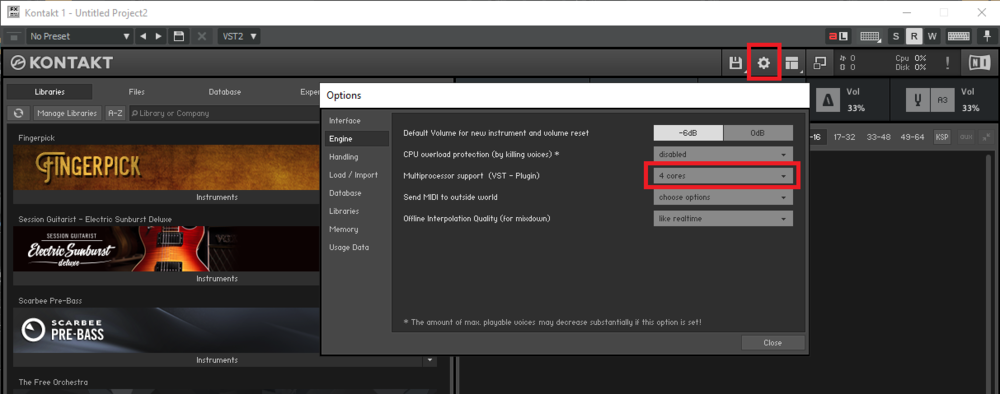-
Posts
7,121 -
Joined
-
Last visited
-
Days Won
39
Everything posted by msmcleod
-
This might explain why my machine started BSOD'ing just after installing the AIR products when I did a "clean" windows upgrade to Windows 10 20H2 (i.e. the one where it wipes out all your program files, but keeps your data). Luckily, I eventually managed to get a normal upgrade to Windows 10 20H2 working in the end, and all my AIR products work normally. So I guess if you've got the option, run the installers on Windows 10 1909, update iLok licence manager - then do your Windows upgrade. Doesn't help people who are already on Windows 10 2004 or 20H2 though. I'm surprised they just don't take the PACE installers out completely, and just tell people to install iLok manager first. I mean... installing AIR products is a PITA anyhow - there's that many files, it's easy to get lost - so adding an extra step isn't going to make a huge difference.
-
The only time I've seen this happen is when using the Realtek ASIO drivers, which are really buggy. Changing the driver mode to WASAPI fixed it for me, so if you're using a Realtek sound device, switch your driver mode within Cakewalk to WASAPI.
-

MIDI Program Change message bug (SOLVED)
msmcleod replied to John Darrow's topic in Cakewalk by BandLab
The only way I can reproduce this behaviour, is when there's also a Program Change set within the track's MIDI inspector, as well as the one in the event list.- 39 replies
-
- bug report
- program change
-
(and 1 more)
Tagged with:
-
One thing I would say though if, for 600GB of data, you're initial sync will be pretty slow (unless you've got a VERY fast upload speed). My connection is 80Mb down / 20Mb up, and it took a few hours for the first upload. Now that's done though, incremental uploads are usually less than 2 mins. I use that time to let me pack some gear away (mics / cables / switch pre-amps off etc), and make sure my phone and keys are in my pocket! The download sync takes less than 20 secs.
-

even numbered inputs on Scarlett 18i20 not listed
msmcleod replied to Penny Fowkes's topic in Instruments & Effects
If you don't like the names, just rename them in Audio->Devices. Each input/output has a "Friendly Name" field. You can name this to what you want, and this will be what is displayed if you check the "Use Friendly Names" checkbox. -
I suspect its an issue with TTS-1 rather than DXi in general. The technology behind DXi's is still widely used in Microsoft products, so if it was fundamentally broken, you'd see issues with video playback and audio playback in a bunch of apps. Unfortunately TTS-1 is a Roland product, so there's not much we can do to fix it.
-

Track template for Vocal doubling with 8 tracks
msmcleod replied to solarlux's topic in Feedback Loop
Pitchproof is a free pitch shift plugin: https://aegeanmusic.com/pitchproof-specs Also, MeldaProduction's FreeBundle has MFreqShifter and MVibrato - both which can be used for pitch shifting effects: https://www.meldaproduction.com/MFreeFxBundle -
I use Mega for backing up my projects. I've only got about 20GB of data though (most of my tracks are MIDI based). This ensures that not only are my projects backed up, I can easily sync between my house PC and my studio PC. The way I do it is: - My main project directory is on one drive (E:\SEQUENCE) - I've got a copy of this directory on another drive (F:\Projects) which is used to sync to Mega - this is important... you can't have the cloudsync accessing files at the same time as Cakewalk. - At the end of a session - I run a batch file which copies any changed files in my main project directory to my sync directory. I then let Mega do its sync. - Before I start a session - I run a different batch file that copies any files that are newer from the sync directory to my project directory My end of session batch file (copy to cloud) ROBOCOPY E:\SEQUENCE F:\Projects\SEQUENCE *.* /XO /E /COPYALL /DCOPY:DAT ROBOCOPY E:\PICTURE F:\Projects\PICTURE *.* /XO /E /COPYALL /DCOPY:DAT ROBOCOPY E:\TEMPLATES F:\Projects\TEMPLATES *.* /XO /E /COPYALL /DCOPY:DAT ROBOCOPY E:\WAVEDATA F:\Projects\WAVEDATA *.* /XO /E /COPYALL /DCOPY:DAT My beginning of session batch file (copy from cloud) ROBOCOPY F:\Projects\SEQUENCE E:\SEQUENCE *.* /XO /E /COPYALL /DCOPY:DAT ROBOCOPY F:\Projects\PICTURE E:\PICTURE *.* /XO /E /COPYALL /DCOPY:DAT ROBOCOPY F:\Projects\TEMPLATES E:\TEMPLATES *.* /XO /E /COPYALL /DCOPY:DAT ROBOCOPY F:\Projects\WAVEDATA E:\WAVEDATA *.* /XO /E /COPYALL /DCOPY:DAT Note: The flags passed to ROBOCOPY make sure only the changed files are copied over.
-
-
The most common reason for this is running Cakewalk as administrator. Windows disables drag/drop behaviour for the administrator account as a security measure. You shouldn't need to run Cakewalk as administrator - the only time when you do is when you first use some older Cakewalk plugins which access protected areas of the registry (sorry, I forget which ones are affected) - however once those keys are created, you should be good to run Cakewalk as the current user.
-
I think this was Cakewalk v2.01 for Windows... just badly labelled. Did Windows 2 ever actually get released/used? I used Windows 1.0 for about 1/2 hour... it crashed on Solitaire! So I promptly uninstalled. I did use Windows 3.0 for a while before Windows 3.11 came out tho. Windows 1.0 kinda reminded me of this:
-

BandLab : Cannot upload from Cakewalk
msmcleod replied to Nelson André's topic in Cakewalk by BandLab
FWIW- I've just tried uploading a project now, and it's working for me. I had to update BandLab Assistant though - make sure you download the latest directly from the website. The Update button didn't work for me. Oh, and you probably know this, but BandLab Assistant needs to be running and logged in when you do the export. -

BandLab : Cannot upload from Cakewalk
msmcleod replied to Nelson André's topic in Cakewalk by BandLab
I've seen this occasionally and raised a ticket with BandLab. Before you do anything, shut down BandLab assistant, download the latest from their website, and install that. Then try again. If it's still not working, send an email to support@bandlab.com -
For trailing notes: If none of the notes end within the section end time + overlap threshold, then the notes will be split at the end of the section. However if one or more notes end within the section end time + overlap threshold, then any other notes after the threshold will be cropped at the threshold limit. Clips cannot be slipped on a note by note basis, so it keeps as much of the note duration as it can. For leading notes: Leading notes that start before the overlap threshold, but end after the section start + threshold will be cropped at the section start. It's worth pointing out though, that although the logic does its best to ascertain which sections notes belong to, it cannot possibly get it right every time. There's no way an algorithm can work out the musical intent of your notes. The larger you make your overlap threshold, the more you should expect to have to tweak the clips afterwards. Personally, I keep my threshold at a tiny amount - i.e. 1/64, 1/128 or 1/256. We did discuss more verbose methods of associating notes to sections, such as being able to individually assign notes to a section. In this case, it'd probably get it right every time, but it would be an arduous task for the user to pick these notes on a note by note basis. So we went with a threshold.
-
I did look into this. The issue isn't with Cakewalk, it's with Windows not notifying Cakewalk. Sometimes I can wait around 20secs to a minute before Windows finally recognises the devices have changed. When Windows does notify Cakewalk of device changes, you get a popup dialog right away. Until Windows actually acknowledges the device exists, a refresh button isn't going to help.
-

Looking for Electric Guitar Solo Samples
msmcleod replied to razor7music's topic in Instruments & Effects
Are you looking for a library pre-canned phrases, or just a library that can do a good rock solo guitar sound? If it's pre-canned phrases you're looking for, I'm not aware of any (if anyone does know of any - please let me know!!) You'll probably have more luck at producer loops or a similar loop library provider, where they have a bunch of "toolkit" type samples you can drag into your project and manipulate. However, they're not cheap, and IMO they're very limited in scope. The best results I've had for guitar solos, believe it or not, is from Band In a Box. [EDIT] - Just found one!! : https://www.wesoundhuman.com/collections/kontakt/products/rock-starter-pack it's half price at $49 atm. -
You may be able to drag/drop the tracks from SONAR to Cubase (or just export the tracks from SONAR and import them into Cubase) Other than that, there's no conversion program I know of to convert SONAR projects to Cubase.
-
One the Melodyne trial period is over, you can no longer save edits. The Cakewalk functions that leverage Melodyne, such as Audio to MIDI and Tempo Extraction will continue to work however. Upgrading to Melodyne Essentials, or one of the other versions will allow you to make edits and save them. Certain functionality is limited however in the cheaper versions. The Celemony website details the differences.
-
There's two functions that do that: Bank Up/Bank Down - move the current track by banks of 8 Channel Up/Channel Down - move the current track by 1 I've checked the code, and the MackieControl is correctly interpreting the HUI versions of those buttons, so you'll just need to make sure they're correctly assigned on the DM2000. I don't think there's anything in MackieControl.dll that would deal with that. However, you could use AZController on that port to map the messages to anything you want - it's complex, but very flexible. @azslow3 has just released a new version today which works better with the 2020.01 release of CbB. The community at http://www.azslow.com/index.php should be able to help you with set up.
-

Inspector Switch Properties view with Keyboard?
msmcleod replied to Colin Nicholls's topic in Cakewalk by BandLab
CTRL + I - toggle Pro Channel/Track Inspector SHIFT + I - toggle Clips props/Track Inspector CTRL + SHIFT + I - toggle track props / Track Inspector SHIFT + ALT + I - toggle arranger / Track Inspector- 1 reply
-
- 3
-

-
CbB does not support sending Sysex to VSTi's.
-
An explanation of what is going on here: 1. The Clips are being rippled by the amount of "clip" that was removed, rather than the whole section extent. This was an old bug. This has now been fixed and will be available in the next update. 2. The notes being deleted is expected due to the size of the overlap threshold (1/4 note) - i.e. as the notes overlap the section end by < 1/4 note, they're being included with the section when it's deleted. Setting a lower threshold amount (or turning it off), splits the notes as expected.





